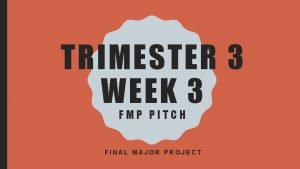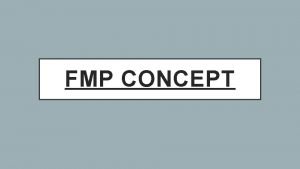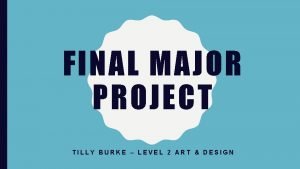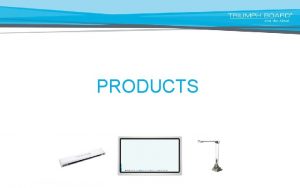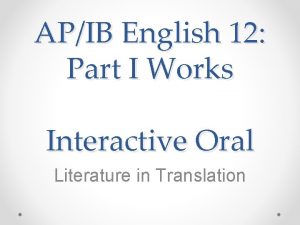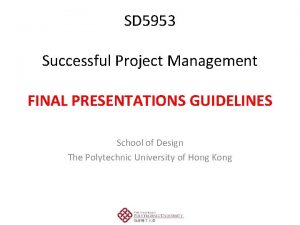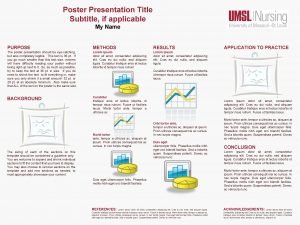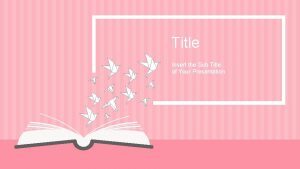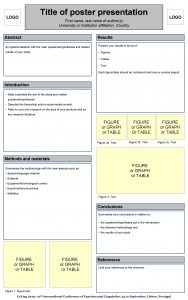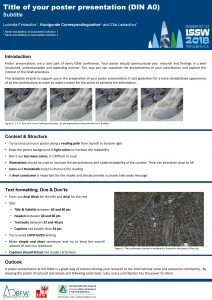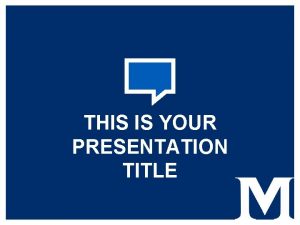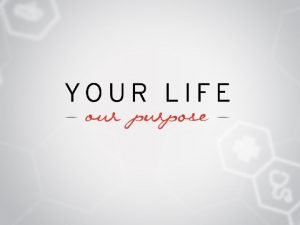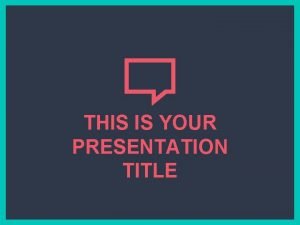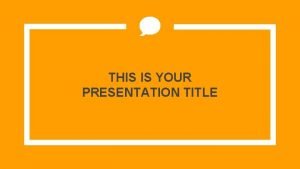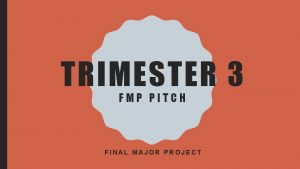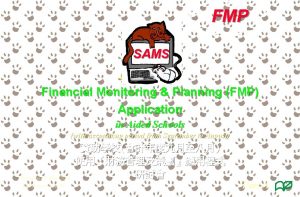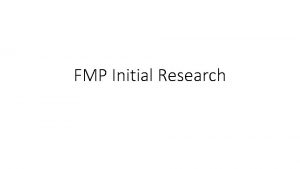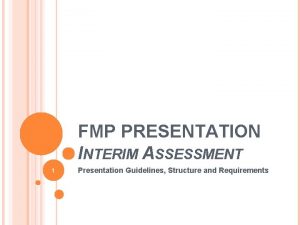FMP PROJECT TITLE An Interactive project Presentation Guidelines


















- Slides: 18

FMP PROJECT TITLE An Interactive project Presentation Guidelines, Structure and Requirements By Andrew Segal

FMP PROPOSAL • KEY Points • Pitch the product- what is it about and where did the idea come from. • Who is it for? Audience • What will you present for the final outcome? • USE WORK FROM YOUR BLOG • Remember…. • Your presentation is 90% (or more!) imagery – 10% (or less!) text • Talk to your audience rather that read to them!

OVERVIEW– Project name • Introduction • Project Title & Explanation • Visuals: • Imagery which helps explain project • Verbal discussion of: Consider concept/idea and audience. • Explanation of your concept, statement of intent, purpose or reason for exploring this idea, starting points of your project

Research • • • Key areas of research Whose work influenced your project? What research have you undertaken ? Include places visited. How will the research inform your product. A few slides describing what the influences for your project are Use the work of at least 2 of your Research references (artists/designers/animators/games designers/filmmakers etc) • Illustrated with examples - with reference

Contextual Reference Present the most important/influential contextual reference or artists to your FMP (no more than 2) Visual: • Present range of images to illustrate the reference Verbal: • Briefly explain the concept/intent of that artists work# • Explain the characteristics of the work – such as the materials, techniques, and processes used to produce this work • Explain SPECIFICALLY why they influenced for your project

Development of Idea • Development sketchs/planning/design sheets/artwork/digital development/etc • Illustrated with examples - with reference to what your development was aboutaesthetic/technical/theoretical/experimental • This should be over a few slides.

Ideas and Theme of Project • What are the main ideas and themes ? • What would you like the audience to feel/experience? • Show a slide of the project here, and explain the STORY/NARRATIVE

Initial Design Sheets and Project Development • A few sheets showing how the ideas developed. • Design sheets for characters/environments/props/vehicles • Storyboards

Your Experimental Stage and Development… Visual: - photographs, scans from your sketchbook, physical experimental pieces • Sketches, illustrations and general idea development • Testing and experimentation of methods, materials, techniques, and processes Verbal: • Have you learned something new? Done something that you have never done before? • Explain what you learned and concluded from experimental stage • How did this process help you to make decisions for the development of your final outcome?

Experimentation and Practical Skills • How you made the product. • What experimentation in materials/techniques/new skills did you use? • A few slides showing your experimentation. • Discuss the decision making you went through from the experimentation stage

CONCEPT ART AND FINALISED DESIGN SHEETS • Include storyboards and digital art.

Project proposal • The final project presented – may be incomplete but you could include final rough version of project… • Show the final project, in whatever state it is currently, demo or test piece. • This will be useful for feedback. • leading up to. .

Final project outcome • What the final product should look like- an example of part of or the whole final project- as this may not be completely finished at this stage, any rough but presentable work would be appropriate. Visual: • Final Designs – based on decisions made from experimentation Verbal: • Who is your audience? • What's the point? ! – what do you aim to achieve with your work? • What are your intentions for how …. • the audience will react to your work? • or interact with your work • or gain an understanding or knowledge of a topic or issue

Conclusion/ evaluation of project • Brief evaluation of project- consider strengths/weaknesses/opportunities and threats (SWOT analysis) • Reflection. Visual: • Failures • Successes or something that you are really proud of? Verbal: • What went wrong? And why? • How did you fix it? Did it work? • Has your FMP changed path in any way?

IS Your FMP COMPLETE? Verbal: • Will you hit the deadline? • What do you have left to do before final submission w/c 14 th May? • Q&A • QUESTIONS!!!!! – ask 3 questions of your peers to help with any aspect of problem solving for you FMP.

FEEDBACK QUESTIONS • Feedback questions for audience- you could hand out a questionnaire or online SURVEY MONKEY/Google docs questionnaire. • These results can be noted and collated and added to your Blog. • Ask and answer any questions about your project. • Try to obtain useful and constructive information that you can use to enhance your final project.

ANY QUESTIONS

The Show – MY PLAN • Give us a DETAILED diagram/design of your ideal show space – draw or digitally design this • There is no guarantee that you will get what you want, but we will do our best • If you don’t do this, we’ll decide for you!
 Fmp proposal example
Fmp proposal example Fmp concept
Fmp concept Fmp ideas art and design
Fmp ideas art and design Interactive keypads suffolk
Interactive keypads suffolk Interactive oral presentation
Interactive oral presentation Evaluation criteria for case study presentation
Evaluation criteria for case study presentation Group presentation guidelines
Group presentation guidelines Prefatory and supplementary part of proposal
Prefatory and supplementary part of proposal Title title
Title title Poster presentation title
Poster presentation title Insert the sub title of your presentation
Insert the sub title of your presentation This is your presentation title
This is your presentation title This is your presentation title
This is your presentation title Poster presentation title
Poster presentation title Poster presentation title
Poster presentation title Transition headline
Transition headline By name title date
By name title date This is your presentation title
This is your presentation title This is your presentation title
This is your presentation title
